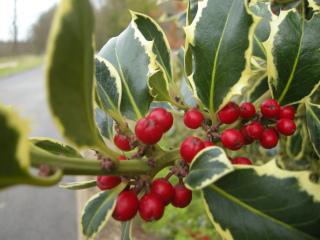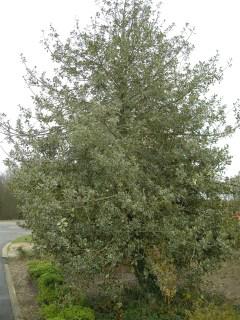
Ilex aquifolium 'Argentea Marginata' Berries (01/12/2011, Cambridge)
Position: Full Sun to Shade
Flowering Period: Spring
Soil: Well Drained
Eventual Height: 10m
Eventual Spread: 6m
Hardiness: USDA Hardiness 7a – 9b
Family: Aquifoliaceae
Ilex aquifolium ‘Argentea Marginata’ is an evergreen small tree or large shrub with a bushy growth habit and goes on to develop a conical crown. The leaves of the plant are broadly ovate, spiny with a bold silver/ yellow margin. They are simple leaves with a waxy texture . This is a female variety of Holly and as such produces berries if a male specimen is in the vicinity. The female flowers of the plant are white in color, are small in size and occur in clusters. The fruit is a small globules, red berry of 8 millimeters in diameter usually red in color. The stems of the are yellow/ green in color, the bark is silver/ gray.
Ilex aquifolium ‘Argentea Marginata’ is commonly known as Silver Margined Holly. This plant is synonymous with Ilex aquifolium ’Argentea Variegata’. Ilex is the only genus of the Aquifoliaceae family. Many parts of the plant are mildly toxic. The origin of the word Holly comes from the 11th Century Old High German hulis and Old English holegn both meaning Holly. The word hulis originates from an even older proto – Germanic word khuli a shortened derivation of the ancient Gaelic cuilieann both meaning Holly. Pure holly woods are unique to Britain and are ecologically equivalent to the evergreen cloud forests of South America and China.
The etymological root of the binomial name Ilex is derived from the old Latin name for this plant. Aquifolium is derived from the Latin acus ’needle’ and floium ’leaf’, in reference to the pointed leaves.

Ilex aquifolium 'Argentea Marginata' (01/12/2011, Cambridge)
The landscape architect may find Ilex aquifolium ‘Argentea Marginata’ useful as evergreen hedge plant or a small specimen tree. This particular variety produces red berries during the winter months and has a silver/ yellow edge to it’s leaves. It is also suitable for maritime planting.
The Royal Horticultural Society has given I. aquifolium ‘Argentea Marginata’ their prestigious award of Garden Merit in 1993.
Ecologically I. aquifolium ‘Argentea Marginata’ is noted for attracting pollinating insects mainly by bees and other such insects. The flowers are sometimes eaten by the larva of the Double striped Pug moth. Other Lepidoptera whose larvae feed on holly include Bucculatrix ilecella. During winter the Holly berries are a very important food source for birds during the winter and birds assist in the dispersal of Holly berries away from the parent tree. During winter storms birds often take refuge in hollies, which provide shelter and protection from predators.
I. aquifolium ‘Argentea Marginata’ prefers a well drained moist soil. It can tolerate most soil pH levels.
Maintenance: This plant requires little to no maintenance. Hedge and tree pruning should take place during the winter months.
